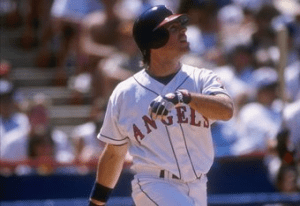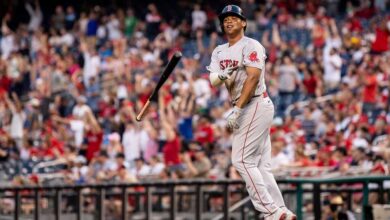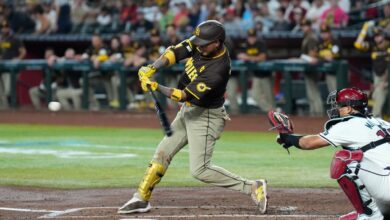Baseball players are, as a general rule, an understated bunch. The sort of press-conference jawing, shameless self-promotion, and openly foul-mouthed feuds that are commonplace in the NFL and NBA are, with very few exceptions (I’m looking at you Jose Canseco), strictly taboo in the Big Leagues. For years, outspoken players have wound up outcasts, objects of derision – look at Jim Bouton, Carlos Zambrano, Curt Schilling, or even the clownish Canseco. We judge baseball players in the same way we judge heroes in B-westerns: the more they speak with physical action and the less they speak with actual words, the more badass they are. So in this terse fraternal culture it should come as no surprise that the absolute penultimate compliment for one boy of summer to bestow upon another is to call him, simply, a Ballplayer. Yes, with a capital “B” – to convey the gruff sense of awe-inspired respect. We’re here today to celebrate a Ballplayer.
On February 18, 2011, Jim Edmonds retired from Major League Baseball, cutting short a potentially heart-warming comeback story with the St. Louis franchise that had paid and loved him during his finest seasons. Edmonds didn’t call it quits because he no longer had the pop in his bat to drop a handful of homerun souvenirs into the eager clutches of the Busch faithful. He didn’t hang ‘em up because he could no longer take a single crow hop in center field and knock the eraser off a pencil held by the third baseman. He didn’t throw in the towel because he no longer felt respected by teammates or appreciated by fans. Because none of these things applied to him. Jim Edmonds retired because he knew he could no longer play the game the way Jim Edmonds played the game. Which was the Right way. All out. Like the Ballplayer he was, and will always be in our memories.
Edmonds retired with 1,949 hits and 393 home runs. Any other player would have struggled to hold on just one more year, knowing he could reach those empty milestones with just a handful of at bats. Not Jim. He knew true Ballplayers were measured in more than numbers. Alex Rodriguez has 220 more home runs, Manny Ramirez has a better batting average by 29 points, but if I were choosing one player to start a team I would choose Edmonds in a heartbeat over either of those guys. Baseball is steeped in numbers and statistics – they are an integral part of its culture. But scouts still put a lot of weight on the unquantifiable qualities or “intangibles,” in scouting lingo, when they assess young players. Prospects are rated on their intangibles as well as their more easily quantifiable skills to this day. My guess is Jim Edmonds was never rated on intangibles because it would have broken, nullified, the very scale itself. If man, as some believe, was created in God’s image, intangibles were created in Jim Edmonds’ image. He is the paradigm and the paragon. The alpha and the omega.
This is not to say Edmonds’ character remains as spotless as that of a choir boy. Jimmy was occasionally prone to minor showboating – but it often added an appropriate finishing flourish to his play – like the pistol twirl of a western gunfighter before re-holstering his weapon after a triumphant shootout. And if the photos and tales found on various sports gossip blogs are to be believed, Edmonds was a fan of the ladies. But not as much as they were fans of him (and his famous “half-shirt” – oddly one of the first suggestions that comes up in a Jim Edmonds Google search). Reciprocation is only polite, after all. Additionally, as with any player with a 30+ homer season during his era, Edmonds has been the subject of the occasional PED whispers. Who knows. But love him or hate him, you must admit the guy could play.
Jim was one of the great defensive centerfielders the league has ever seen – not because he ran the fastest 40, or had the highest vertical leap, but because his heart was made of rawhide with red stitching. I don’t mean to make Edmonds out to be some kind of Natural. He was a gritty player, but he was also a student of the game whose brain may have been his greatest weapon. He would not only study opposing batters’ tendencies, but would analyze the habits of pitchers on his own team, take into account things like wind direction and speed and the phase of the moon, plug all of these variables into an unconscious Einsteinian equation in his ever-active brain, and position himself in exactly the right place. Pretty much every time, if you ask managers and teammates who observed him closely.
All this being said, Jim Edmonds will not make the Hall of Fame. Those who accumulate statistics and attain the proper milestones will be enshrined. Those who play the game as hard as it can be played and, when their time has come, put themselves out to pasture rather than struggling and faltering and slowly fading sometimes hav e slimmer chances at the Hall. But what hat would he wear, were he somehow to reach Cooperstown? Many will remember Jim Edmonds as a Cardinal, and I completely understand. It was there he had his finest statistical years, first over-shadowed by an artificially beefy, HR-record-breaking Mark McGwire, and then a leaner hitting machine in the young Albert Pujols. Edmonds would never complain – Pujols even refers to him as his “mentor”. By all locker room accounts, you’d never meet a guy more committed to the team, or more capable of leading by example in the most pressure-filled moments. It was then that Jimmy shined his brightest. Who’ll forget his 12th inning walk-off bomb in the 2004 NLCS. Edmonds finished with 13 career post-season homers, all with the Cards. And apparently he even had a knack for pumping up the team for postseason matchups in the locker room. So I understand the St. Louis sentiment.
e slimmer chances at the Hall. But what hat would he wear, were he somehow to reach Cooperstown? Many will remember Jim Edmonds as a Cardinal, and I completely understand. It was there he had his finest statistical years, first over-shadowed by an artificially beefy, HR-record-breaking Mark McGwire, and then a leaner hitting machine in the young Albert Pujols. Edmonds would never complain – Pujols even refers to him as his “mentor”. By all locker room accounts, you’d never meet a guy more committed to the team, or more capable of leading by example in the most pressure-filled moments. It was then that Jimmy shined his brightest. Who’ll forget his 12th inning walk-off bomb in the 2004 NLCS. Edmonds finished with 13 career post-season homers, all with the Cards. And apparently he even had a knack for pumping up the team for postseason matchups in the locker room. So I understand the St. Louis sentiment.
For me, though, Jim Edmonds will always be an Angel. I was 12 years old and eating, sleeping and breathing baseball, trying to help my team to the Little League World Series when he burst onto the scene in 1995. Edmonds embodied everything a young ballplayer looked up to: intensity and humility, loud plays and quiet words. He served as the keystone of one of the better hitting outfields of our time, along with the already forgotten Tim Salmon and Garrett Anderson. And it was as an Angel in the California, then Anaheim (yeah, it was that long ago they started the silly name-changing game) outfield that Jim Edmonds first showed the 5 o’clock shadow and uninhibited style of play that would become his calling cards. He was one of those rare players who was not a product of his time, but would’ve fit in any era of the game of baseball, from its very inception. His peers will miss him, fans across the league should miss him, but don’t let history miss Jim Edmonds. A Ballplayer. One of the true and only.





